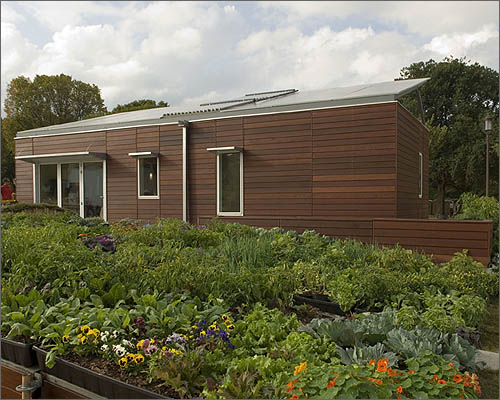
Image Credit: Cornell University/DOE Solar Decathlon
Massachusetts builders and remodelers talk strategy for meeting a proposed net-zero home construction goal – and for striving toward net-zero in existing homes
Last week we mentioned the challenges facing a “stretch” energy code amendment proposed by the Massachusetts Board of Building Regulations and Standards. The BBRS sought comments on the proposal until Tuesday, and will vote on it in the coming weeks.
The stretch code would give municipalities the option of adopting higher energy-efficiency standards for residential and commercial construction, including a HERS index score of 60 or less for new single-family and multifamily homes, and a HERS of 70 for major renovations. Green builders and remodelers are for the measure, the Home Builders Association of Massachusetts has a well organized campaign against it.
But as a recent post on the Coastal Contractor website points out, there’s an equally vigorous discussion underway regarding strategies for making all new construction in Massachusetts zero net energy by 2030. The Massachusetts Zero Net Energy Buildings Task Force, appointed by Governor Deval Patrick in March 2008, submitted its final report to the governor on March 11, 2009.
Titled “Getting to Zero,” the report (click here for PDF) provides data and ideas for addressing the environmental, financial, regulatory, and timing issues that will come into play as the state sets and then tries to meet its goals.
In general, the report suggests that Massachusetts “issue specifications for the first, state-owned zero net energy building by January 1, 2010; develop specifications for an interim standard for state-owned construction that is significantly more stringent than the Massachusetts LEED Plus benchmark; and implement programs that will “put the private sector on a path toward (1) broad marketability of zero net energy commercial and residential buildings by 2020 and (2) universal adoption of zero net energy practices for new commercial and residential construction by 2030.”
A clear-eyed perspective
The report then acknowledges a couple important realities: “First, recognizing that, even by 2030, achieving the zero net energy performance goal may be infeasible for some buildings, the broader objective should be to reduce energy loads to the minimum practical level, produce onsite as much of the required energy as reasonable from renewable resources, and purchase locally generated renewable energy to satisfy remaining needs.
“Second, the extended lifetime of a typical building dictates that the absolute magnitude of potential energy reductions associated with the existing building stock will be far greater than those associated with new buildings alone, so developing recommendations that do not address the energy performance of existing buildings would result in a significant missed opportunity for reducing the overall energy needs, and carbon footprint, of the state.”
No one expected this to be easy.
Emile Chin-Dickey, a partner at architecture firm ZeroEnergy Design, based in Charlestown, Massachusetts, told Coastal Contractor that, even though business, design, and construction models for zero net energy construction are readily available, getting to net zero energy in new-home construction by 2030 will be a major challenge.
“That’s going to be very difficult to achieve,” he said. “And it’s not going to be a single product or method that gets us there. It’s going to be a continuous effort, and they’ve got to be coordinated.”
But remodeler Paul Eldrenkamp, a proponent of the stretch code and chair of the Zero Net Energy Buildings Task Force’s residential committee, pointed out that addressing the energy efficiency needs of existing buildings, as the task force report recommends, would indeed “offer much greater opportunity” for reductions grid-supplied usage, especially relative to what can be achieved in new-home construction.
“In a good year, there are 20,000 or 25,000 new housing starts in Massachusetts,” he told the Coastal Contractor, “and we’ve got 2.2 million existing dwelling units.”
Weekly Newsletter
Get building science and energy efficiency advice, plus special offers, in your inbox.















0 Comments
Log in or create an account to post a comment.
Sign up Log in